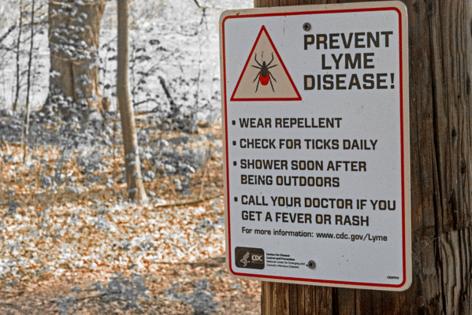Ask the Pediatrician: Diseases spread by mosquitoes and ticks -- Information for families
Published in Health & Fitness
Infectious diseases spread by insects are a major cause of illnesses to children and adults worldwide. As you spend time with family outdoors, keep everyone safe with knowledge of the diseases spread by mosquitoes and ticks.
Besides being itchy annoyances, mosquito bites can transmit a number of diseases such as West Nile virus and La Crosse virus, both of which get plenty of media coverage during the summer months in the U.S. due to the potential encephalitis (brain swelling) they can cause.
West Nile virus is the leading cause of mosquito-borne illness disease in the United States. Fortunately, most cases of West Nile virus infection are mild or without symptoms. People may have symptoms such as fever, headache and body aches. Less common symptoms, which occur mostly in older adults, may include severe headache, high fever, stiff neck, confusion, seizures, sensitivity to light, muscle weakness and loss of consciousness.
La Crosse virus has become the second most common disease transmitted by mosquito bites in children. Severe disease after being infected by the virus happens most often in children under 16 years old. The majority of infected children have symptoms due to brain swelling such as fever, stiff neck, confusion and seizures. Fortunately, despite these serious symptoms, few have died from La Crosse virus infection.
Zika virus is another illness primarily spread by mosquitoes with infection during pregnancy potentially causing fetuses to develop a birth defect called microcephaly. Outbreaks are currently happening in many countries and territories. Many people who get infected with Zika virus either won't have symptoms or they will be very mild. Symptoms include fever, headaches, swollen limbs, itchy rash, joint pain or red eyes.
Tick bites are also a source of potential infections. Lyme disease is spread by deer ticks -- tiny, black-brown arachnids about the size of a sesame seed. Ticks, which have 8 legs and a tiny pincer mouth, need to be attached for at least 36 hours and be swollen from their so called “blood meal” to transmit Lyme disease to a person.
Lyme disease is an important health concern in certain regions of the country: Northeast, from Virginia to Maine; north-central states, mostly Wisconsin and Minnesota; and the West Coast, particularly northern California.
Often the first and most obvious symptom of Lyme disease is a localized rash. The Lyme disease rash begins as a pink or red circle at the site of tick attachment. This circle expands over time and may become several inches or larger. A classic bulls-eye appearance, with concentric rings, appears in some people.
The Lyme disease rash generally occurs 1 to 2 weeks after the tick bite, but ranges from 3 days to 30 days. The rash may develop without any other symptoms, or it may be associated with headache, chills, fever, fatigue, muscle and joint pain, and swollen glands, especially those in the neck or groin.
Rocky Mountain spotted fever is another disease spread by ticks that children are especially vulnerable to. The disease is particularly deadly, becoming fatal after the first 5 days if antibiotics aren’t administered.
Despite the name, Rocky Mountain spotted fever currently occurs mostly in other regions of the United States, including North and South Carolina, Oklahoma and Tennessee.
Most people develop a red, dot-like rash that begins on the wrists and ankles and spreads toward the center of the body. Symptoms may present with faint rashes also in palms and soles or no rash at all. In addition to a rash, other symptoms of Rocky Mountain spotted fever may include severe headache, fever, muscle aches, abdominal pain, nausea and diarrhea or vomiting.
Since 2004, when Powassan virus infection began to be tracked, many cases have been reported from April to December. This disease is transmitted mainly by deer ticks. The transmission can occur as quickly as 15 minutes after the tick is attached.
Although the majority of people who get sick with Powassan virus infection are older adults, an infant was reported as infected in 2016. This child began having fever and vomiting followed by seizures.
With some of these diseases being transmitted by ticks, it is crucial to limit the risk of being bitten. Children need and love to be outdoors. The chance of your children becoming infected by insects and ticks is quite low, especially when you take steps to reduce the risk of bites.
To prevent mosquito and tick bites, it is safe to use repellents or wear permethrin-treated clothing. For younger children, repellents should not be applied to the hands or face and should be used as few times during the day as possible. Repellents should not be used on infants under 6 months of age.
If your child plays outside in an area where ticks live, it is very important to check for ticks on their skin daily. Removing clothing and showering promptly after being outside can help remove unattached ticks.
If your child has a bug bite and shows symptoms of West Nile, La Crosse, Zika, Lyme disease, Rocky Mountain spotted fever, Powassan virus infection or other illnesses spread by mosquitoes or ticks, talk with your pediatrician.
____
Andrew Bernstein, MD, FAAP is a general pediatrician in the Chicago area.
____
©2025 Tribune Content Agency, LLC.










Comments